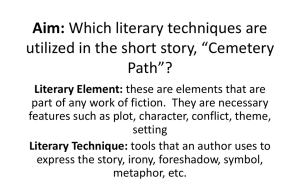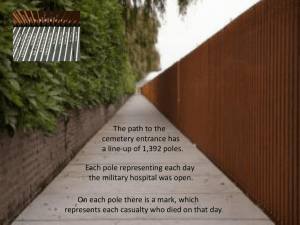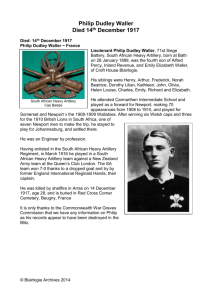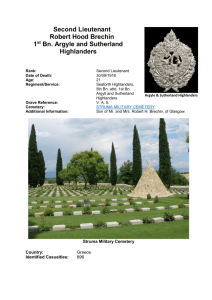docx
advertisement
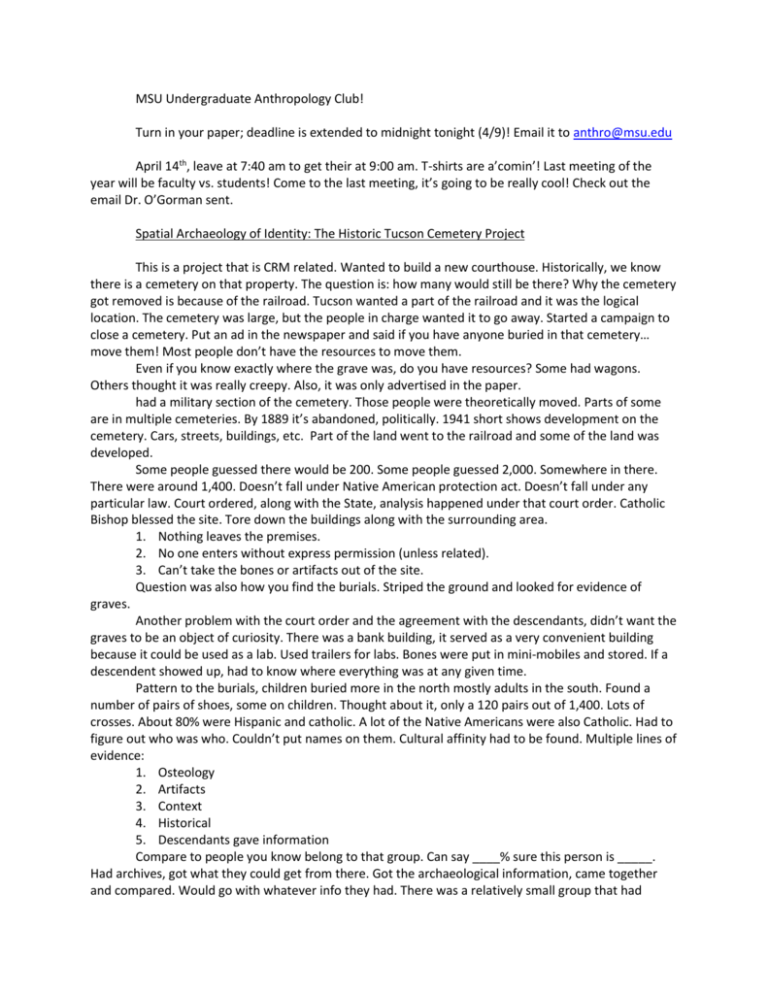
MSU Undergraduate Anthropology Club! Turn in your paper; deadline is extended to midnight tonight (4/9)! Email it to anthro@msu.edu April 14th, leave at 7:40 am to get their at 9:00 am. T-shirts are a’comin’! Last meeting of the year will be faculty vs. students! Come to the last meeting, it’s going to be really cool! Check out the email Dr. O’Gorman sent. Spatial Archaeology of Identity: The Historic Tucson Cemetery Project This is a project that is CRM related. Wanted to build a new courthouse. Historically, we know there is a cemetery on that property. The question is: how many would still be there? Why the cemetery got removed is because of the railroad. Tucson wanted a part of the railroad and it was the logical location. The cemetery was large, but the people in charge wanted it to go away. Started a campaign to close a cemetery. Put an ad in the newspaper and said if you have anyone buried in that cemetery… move them! Most people don’t have the resources to move them. Even if you know exactly where the grave was, do you have resources? Some had wagons. Others thought it was really creepy. Also, it was only advertised in the paper. had a military section of the cemetery. Those people were theoretically moved. Parts of some are in multiple cemeteries. By 1889 it’s abandoned, politically. 1941 short shows development on the cemetery. Cars, streets, buildings, etc. Part of the land went to the railroad and some of the land was developed. Some people guessed there would be 200. Some people guessed 2,000. Somewhere in there. There were around 1,400. Doesn’t fall under Native American protection act. Doesn’t fall under any particular law. Court ordered, along with the State, analysis happened under that court order. Catholic Bishop blessed the site. Tore down the buildings along with the surrounding area. 1. Nothing leaves the premises. 2. No one enters without express permission (unless related). 3. Can’t take the bones or artifacts out of the site. Question was also how you find the burials. Striped the ground and looked for evidence of graves. Another problem with the court order and the agreement with the descendants, didn’t want the graves to be an object of curiosity. There was a bank building, it served as a very convenient building because it could be used as a lab. Used trailers for labs. Bones were put in mini-mobiles and stored. If a descendent showed up, had to know where everything was at any given time. Pattern to the burials, children buried more in the north mostly adults in the south. Found a number of pairs of shoes, some on children. Thought about it, only a 120 pairs out of 1,400. Lots of crosses. About 80% were Hispanic and catholic. A lot of the Native Americans were also Catholic. Had to figure out who was who. Couldn’t put names on them. Cultural affinity had to be found. Multiple lines of evidence: 1. Osteology 2. Artifacts 3. Context 4. Historical 5. Descendants gave information Compare to people you know belong to that group. Can say ____% sure this person is _____. Had archives, got what they could get from there. Got the archaeological information, came together and compared. Would go with whatever info they had. There was a relatively small group that had conflicting clues. Found that most of the individuals could be dealt with. If they had multiple IDs with others, just put multiple. Very easy to tell how they came to that conclusion. One of the most interesting things about the project was there was 120 buttons made out of shell. What was unusual, about 100 of them were individually carved. That’s unusual because they are smaller buttons with very small details. They were doing it for themselves. Same thing as whittling. One button had a Star of David, at the tow end of the grave there was a cross thrown in. May have been Jewish but could have been coming through and died. Others may have placed the cross in the grave. Had to dig the garbage to make sure there were no bones. Any Native groups that were identified as such could either take the remains back or they could leave the remains and they would be reburied. The new cemetery is on the edges of Tucson, not the popular cemetery. All faiths cemetery. Took the front of the cemetery and the first thing you see is a new, old cemetery. Military did a whole different world. Had 58 individuals who were in the military section of the cemetery. Moved in the 1900s. Just took what they could. On a number of the bodies there were hands and feet left. Had small caskets. Military feels very strongly that they want you to know that if you are in the military you will never be forgotten. They will never leave you behind. They created a whole new historic military cemetery at the military cemetery. Military people came to rebury them. Had special flags made which would be appropriate to the times. Got the Unknown Soldier marker. Brought out re-enactors. 1860s re-enactors. Buffalo soldiers also came. Let the Buffalo soldiers participate, had one Buffalo soldier in the group. Calvary came! Guns were going off, over 2,000 people in the ceremony. The boy scouts were also there. Arizona’s official balladeer: Dolan Ellis was there. Walked with two people on a coffin. Buffalo soldiers got to carry the Buffalo soldier. Military was sending a very clear message that “we will not leave you behind.” Reburied the bodies in the same relative order. Had a priest, a minister, and a rabbi present. Did a ceremony. Prayed over the first individual. Took almost two weeks to put everybody in the ground. Put stone over top. Rough stone so people don’t walk on it. Has a plaza, explains what the area is. Re-burial ceremony. No band, no shotguns, no nothing. Released doves. One of the people on the project came up to her and was very upset that a dove was released. Released white honing pigeons. The descendent groups were involved from the very beginning. A lot of negotiation back and forth. Cemetery many didn’t know about and they put forth so much energy and emotion. It’s fascinating! People really felt very strongly about it. The idea that Tucson could trash 2,000 burials because they wanted to be a part of the railroad didn’t sit well with people. In several instances knew military bones had been moved, wanted to get all the pieces of the individual together. Military refused. Didn’t matter to them. What was important was the burial itself. It really matters to a lot of living people. Communicate directly and transparently. If you can’t defend it, there’s a problem with you doing it. You just can’t assume you know what someone is going to do.


